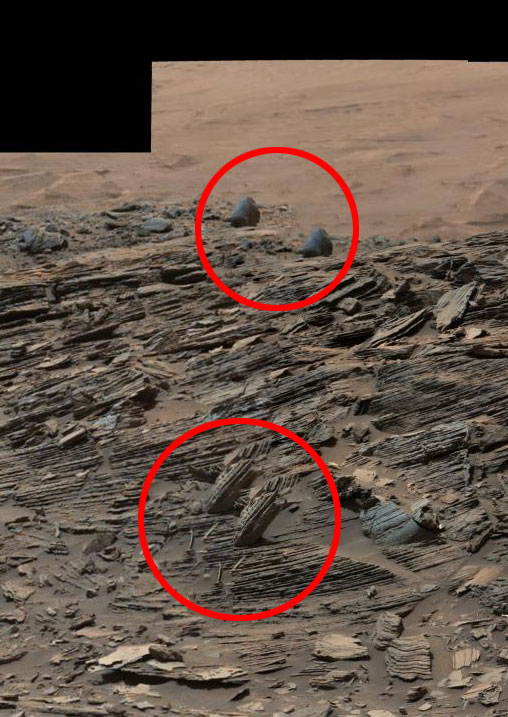 Vlad's
Science Corner
Vlad's
Science Corner 
Brought to you by the Psychic Energy Lab at Triplotz University, Potzderanja
Sep. 11, 2015
Hello everyone !
Today we will observe a new panoramic photo made by Curiosity, our American colleague's fabulous rover on Mars, still functioning superbly and exploring the red planet after almost four years. The original file can be seen HERE on the NASA website.
Below is a reduced view :
By passing your mouse over the above image you will see two zones highlighted on the left. Below is an enlargment of this area.

As you can clearly see some rocks appear twice and are identical. At first I thought this might be an error from the panorama making application at Nasa's photo department but this is highly unlikely as we all know how serious and thorough they are in their work. So the only other explanation is that Martian physics are slightly different from ours on a quantic level. This seems to be a glitch in the Martian quantic field where the same objects appear to be at two places at the same time. This kind of anomaly in the space time continuum is totally unheard of here on Earth or elsewhere in our solar system and as far as we know this is the first noted occurence of such a phenomenon. Surprisingly, Nasa does not seem to have noticed this, so we have sent word to them and are expecting their prompt reply. Once again Triplotz University finds itself at the forefront of modern research and I must say I am quite proud of our discovery. We are still investigating this startling phenomenon and will post more details soon.
Scientifically yours,
Vlad
P.S.: What do you think of this extraordinary happenstance ? Share your own thoughts and theories with us at potzderanja.edu at free.fr
Sep. 12, 2015
Update
: It seems this Martian glitch may be an illustration of very recent findings
made at the Large
Hadron Collider at the CERN in Geneva as explained in this
Nature article.
For my physician colleagues, here is the
abstract for this research.
I quote:
"The
branching fraction ratio![]() is
measured using a sample of proton-proton collision data corresponding
to 3.0\invfb of integrated luminosity recorded by the LHCb experiment
during 2011 and 2012. The tau lepton is identified in the decay mode
is
measured using a sample of proton-proton collision data corresponding
to 3.0\invfb of integrated luminosity recorded by the LHCb experiment
during 2011 and 2012. The tau lepton is identified in the decay mode![]() .
The semitauonic decay is sensitive to contributions from non-Standard-Model
particles that preferentially couple to the third generation of fermions,
in particular Higgs-like charged scalars. A multidimensional fit to kinematic
distributions of the candidate
.
The semitauonic decay is sensitive to contributions from non-Standard-Model
particles that preferentially couple to the third generation of fermions,
in particular Higgs-like charged scalars. A multidimensional fit to kinematic
distributions of the candidate ![]() decays gives
decays gives ![]() =0.336±0.027(stat)±0.030(syst).
This result, which is the first measurement of this quantity at a hadron
collider, is 2.1 standard deviations larger than the value expected from
lepton universality in the Standard Model."
=0.336±0.027(stat)±0.030(syst).
This result, which is the first measurement of this quantity at a hadron
collider, is 2.1 standard deviations larger than the value expected from
lepton universality in the Standard Model."
Exactly like I thought !
Scientifically yours,
Vlad

